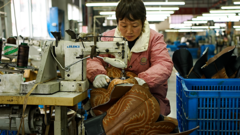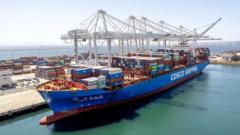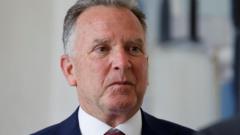The anticipated return of Trump's tariffs has Chinese manufacturers taking a cautious approach, navigating the uncertain landscape of US-China trade relations.
Trump's Tariff Threats Resurface as Chinese Manufacturers Brace for Impact

Trump's Tariff Threats Resurface as Chinese Manufacturers Brace for Impact
As former President Trump threatens new tariffs on Chinese goods, factories in China prepare for the potential fallout.
In a factory along China’s eastern coast, workers deftly produce cowboy boots, a once-thriving business that now faces renewed challenges from US tariffs. Sales manager Mr. Peng remembers a time when his factory sold around a million pairs of boots annually before the onset of the trade war instigated by former President Trump. Now, at the inception of “Trump 2.0” with his potential return to the White House, Chinese businesses are bracing themselves for another round of tariffs that could materialize as early as February.
For many in the industry, including Mr. Peng and his colleagues, the looming threat of a 10% tariff sent a chill through the manufacturing sector. With the Chinese economy increasingly reliant on exports amid sluggish growth, trade has transformed into a strategic weapon, complicating relationships between the two superpowers. Concurrently, major multinational companies like Nike and Adidas have begun relocating operations to Southeast Asia as a preemptive measure against rising costs in China.
Despite this unsettling environment, Mr. Peng, who views his workplace as family, expresses a desire to remain in the region and support his long-tenured employees. However, the stark reality remains—his factory, which once employed over 500 workers, now barely surpasses 200, reflecting a grim consequence of previous tariffs. The painstaking process behind crafting each pair of boots has not only garnered a reputation for quality but also come at great expense in the face of dwindling orders.
The tangible impact of Trump’s tariffs has extended beyond manufacturing; the repercussions of this trade offense resonate throughout the supply chain. Some American buyers are already contemplating moves away from China to mitigate potential financial losses. For instance, Mr. Huang Zhaodong, a businessman who has expanded operations to Cambodia, has founded factories that cater to US retailers like Walmart and Costco. His strategy hinges on affordability, as increased tariffs on Chinese goods would significantly reduce profit margins, making it unsustainable to operate in the country under such conditions.
Currently, US tariffs on Chinese imports vary widely, with comprehensive blanket tariffs potentially threatening everything from electronics to garments. As pricing pressures mount, many manufacturers are wrangling with customers who are pushing for relocation to avoid tariff implications. Chinese-run factories in Cambodia have flourished as a result, with research showing they account for a significant portion of the local garment industry.
Yet, the shifting dynamics extend beyond tariffs. China's Belt and Road Initiative has strategically expanded its influence in Southeast Asia, ensuring that trade routes remain open albeit outside its borders. Many countries in these regions are increasingly reliant on Chinese manufacturing and investment, a trend that appears to counterbalance the United States’ efforts to sway trading patterns back in its favor.
According to experts, the evolving landscape demands that Chinese companies not only reactively relocate but also evaluate expansion opportunities in emerging markets beyond Asia, such as Africa and Latin America. As the US pledges an “America First” approach, Chinese businesses are attempting to present themselves as stable partners in the global economy.
As uncertainties loom, Mr. Peng holds hope for improved US-China relations, favoring dialogue over tariffs. “An amicable discussion can help keep tariffs in check,” he suggests, sharing the sentiment that American consumers still require quality products produced on Chinese soil. Meanwhile, businesses in both nations prepare for what could be a turbulent yet critical chapter in their shared economic narrative.




















